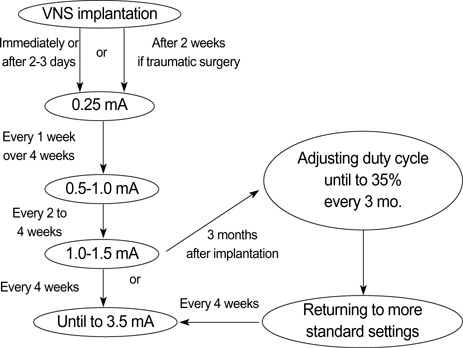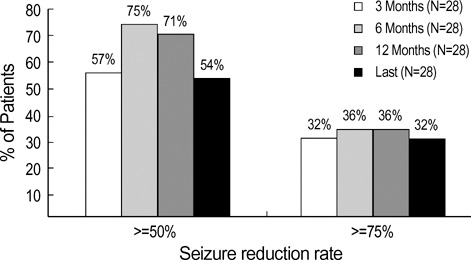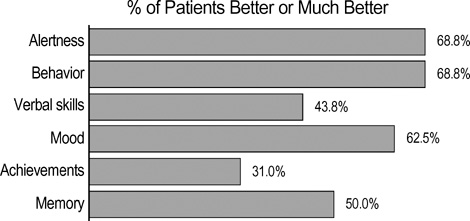J Korean Med Sci.
2007 Jun;22(3):442-445. 10.3346/jkms.2007.22.3.442.
Vagus Nerve Stimulation in Intractable Childhood Epilepsy: a Korean Multicenter Experience
- Affiliations
-
- 1Department of Pediatrics, Epilepsy Center, Inje University College of Medicine, Sanggye Paik Hospital, Seoul, Korea.
- 2Department of Pediatrics, Pediatric Epilepsy Clinics, Severance Child's Hospital, Brain Research Institute, Yonsei University College of Medicine, Seoul, Korea.
- 3Department of Pediatrics, Asan Medical Center, Ulsan University College of Medicine, 388-1 Pungnap-dong, Songpa-gu, Seoul, Korea. tsko@amc.seoul.kr
- 4Department of Pediatrics, Kangbuk Samsung Hospital, Sungkyunkwan University School of Medicine, Seoul, Korea.
- 5Department of Neurosurgery, Epilepsy Center, Inje University College of Medicine, Sang-gye Paik Hospital, Seoul, Korea.
- 6Department of Neurosurgery, Severance Hospital, Handicapped Children's Research Institute, Brain Research Institute, Yonsei University College of Medicine, Seoul, Korea.
- 7Department of Neurosurgery, Ulsan University College of Medicine, Asan Medical Center, Seoul, Korea.
- KMID: 1778351
- DOI: http://doi.org/10.3346/jkms.2007.22.3.442
Abstract
- We evaluated the long-term outcome of vagus nerve stimulation (VNS) in 28 children with refractory epilepsy. Of these 28 children, 15 (53.6%) showed a >50% reduction in seizure frequency and 9 (32.1%) had a >75% reduction. When we compared seizure reduction rates according to seizure types (generalized vs. partial) and etiologies (symptomatic vs. cryptogenic), we found no significant differences. In addition, there was no correlation between the length of the stimulation period and treatment effect. The seizure reduction rate, however, tended to be inversely related to the seizure duration before VNS implantation and age at the time of VNS therapy. VNS also improved quality of life in this group of patients, including improved memory in 9 (32.1%), improved mood in 12 (42.9%), improved behavior in 11 (39.3%), improved altertness in 12 (42.9%), improved achievement in 6 (21.4%), and improved verbal skills in 8 (28.6%). Adverse events included hoarseness in 7 patients, dyspnea at sleep in 2 patients, and wound infection in 1 patient, but all were transient and successfully managed by careful follow-up and adjustment of parameters. These results indicate that VNS is a safe and effective alternative therapy for pediatric refractory epilepsy, without significant adverse events.
Keyword
MeSH Terms
Figure
Reference
-
1. Helmers SL, Wheless JW, Frost M, Gates J, Levisohn P, Tardo C, Conry JA, Yalnizoglu D, Madsen JR. Vagus nerve stimulation therapy in pediatric patients with refractory epilepsy: retrospective study. J Child Neurol. 2001. 16:843–848.
Article2. Murphy JV, Torkelson R, Dowler I, Simon S, Hudson S. Vagal nerve stimulation in refractory epilepsy: the first 100 patients receiving vagal nerve stimulation at a pediatric epilepsy center. Arch Pediatr Adolesc Med. 2003. 157:560–564.3. Lim K, Kang HC, Kim HD. Validation of a Korean version of the Quality of Life in Childhood Epilepsy Questionnaire (K-QOLCE). J Korean Epilepsy Soc. 2002. 6:32–44.4. Kang HC, Kim HD, Hwang YS, Park SK. Therapeutic outcomes of vagus nerve stimulation in intractable childhood epilepsy. J Korean Epilepsy Soc. 2003. 7:118–124.5. Labar D. Vagus nerve stimulation for 1 year in 269 patients on unchanged antiepileptic drugs. Seizure. 2004. 13:392–398.
Article6. Renfroe JB, Wheless JW. Earlier use of adjunctive vagus nerve stimulation therapy for refractory epilepsy. Neurology. 2002. 59:26–30.
Article7. You SJ, Kim DS, Lee JK, Ko TS. Vagus nerve stimulation in intractable pediatric epilepsy patients. J Korean Child Neurol Soc. 2005. 13:8–14.8. Tanganelli P, Ferrero S, Colotto P, Regesta G. Vagus nerve stimulation for treatment of medically intractable seizures. Evaluation of long-term outcome. Clin Neurol Neurosurg. 2002. 105:9–13.
Article9. Parain D, Penniello MJ, Berquen P, Delangre T, Billard C, Murphy JV. Vagal nerve stimulation in tuberous sclerosis complex patients. Pediatr Neurol. 2001. 25:213–216.
Article10. Murphy JV, Wheless JW, Schmoll CM. Left vagal nerve stimulation in six patients with hypothalamic hamartomas. Pediatr Neurol. 2000. 23:167–168.
Article11. DeGiorgio CM, Schachter SC, Handforth A, Salinsky M, Thompson J, Uthman B, Reed R, Collins S, Tecoma E, Morris GL, Vaughn B, Naritoku DK, Henry T, Laber D, Gilmartin R, Labiner D, Osorio I, Ristanovic R, Jones J, Murphy J, Ney G, Wheless J, Lewis P, Heck C. Prospective long-term study of vagus nerve stimulation for the treatment of refractory seizures. Epilepsia. 2000. 41:1195–1200.
Article12. Morris GL 3rd, Mueller WM. Long-term treatment with vagus nerve stimulation in patients with refractory epilepsy. The Vagus Nerve Stimulation Study Group E01-E05. Neurology. 1999. 53:1731–1735.13. Patwardhan RV, Stong B, Bebin EM, Mathisen J, Grabb PA. Efficacy of vagal nerve stimulation in children with medically refractory epilepsy. Neurosurgery. 2000. 47:1353–1357.
Article14. Valencia I, Holder DL, Helmers SL, Madsen JR, Riviello JJ Jr. Vagus nerve stimulation in pediatric epilepsy: a review. Pediatr Neurol. 2001. 25:368–376.
Article15. Buoni S, Mariottini A, Pieri S, Zalaffi A, Farnetani MA, Strambi M, Palma L, Fois A. Vagus nerve stimulation for drug-resistant epilepsy in children and young adults. Brain Dev. 2004. 26:158–163.
Article16. Hallbook T, Lundgren J, Stjernqvist K, Blennow G, Strombald LG, Rosen I. Vagus nerve stimulation in 15 children with therapy resistant epilepsy; its impact on cognition, quality of life, behaviour and mood. Seizure. 2005. 14:504–513.
Article17. Wheless JW, Maggio V. Vagus nerve stimulation therapy in patients younger than 18 years. Neurology. 2002. 59:S21–S25.
Article18. Majoie HJ, Berfelo MW, Aldenkamp AP, Renier WO, Kessels AG. Vagus nerve stimulation in patients with catastrophic childhood epilepsy, a 2-year follow-up study. Seizure. 2005. 14:10–18.
Article
- Full Text Links
- Actions
-
Cited
- CITED
-
- Close
- Share
- Similar articles
-
- Vagus Nerve Stimulation Therapy in Refractory Epilepsy: 18-Month Follow-up Multicenter Study
- Anesthetic Experience of Vagus Nerve Stimulator Insertion for Intractable Epilepsy Patients: 18 Cases : A case report
- Therapeutic Outcomes of Vagus Nerve Stimulation in Intractable Childhood Epilepsy
- The Present and Future of Vagus Nerve Stimulation
- Therapeutic Effects of Vagus Nerve Stimulation in Intractable Childhood Epilepsy: Experience for 12 Months after VNS Implantation




